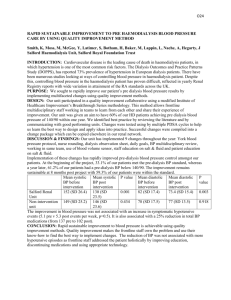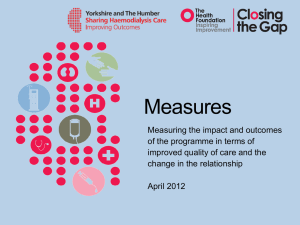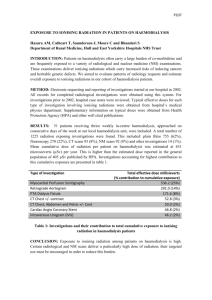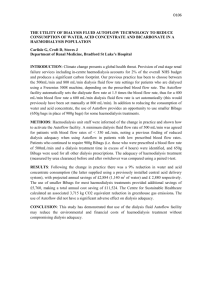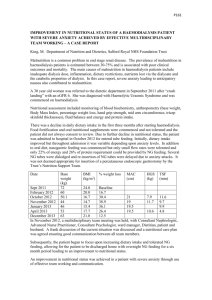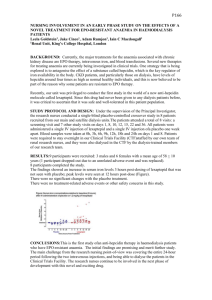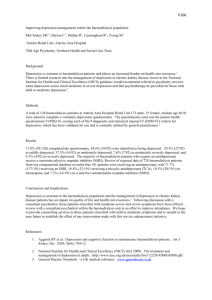Haemodialysis - Renal Resource Centre
advertisement
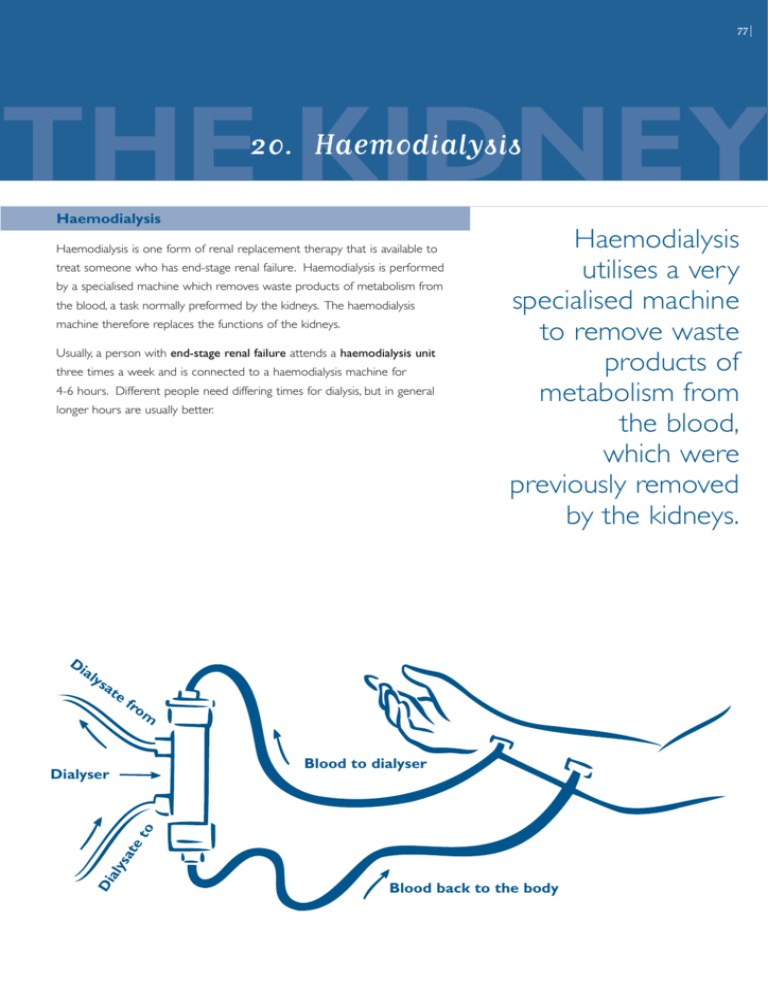
77 THE KIDNEY 20. Haemodialysis Haemodialysis Haemodialysis is one form of renal replacement therapy that is available to treat someone who has end-stage renal failure. Haemodialysis is performed by a specialised machine which removes waste products of metabolism from the blood, a task normally preformed by the kidneys. The haemodialysis machine therefore replaces the functions of the kidneys. Usually, a person with end-stage renal failure attends a haemodialysis unit three times a week and is connected to a haemodialysis machine for 4-6 hours. Different people need differing times for dialysis, but in general longer hours are usually better. Di aly sa te Haemodialysis utilises a very specialised machine to remove waste products of metabolism from the blood, which were previously removed by the kidneys. fro m Di aly sa te to Dialyser Blood to dialyser Blood back to the body 78 A G U I D E F O R PAT I E N T S Ideally, access to the blood circulation for haemodialysis treatments is completed by inserting a fine needle into a permanent vascular access surgically created in either the forearm or the thigh. Haemodialysis continued... A small number of patients connect themselves to haemodialysis machines at home in what is called home haemodialysis. Sometimes, these patients sleep through the treatment at night in what is called overnight home haemodialysis. In this way, these people have approximately 8-10 hours haemodialysis treatment three nights per week. Ideally, access to the blood circulation for haemodialysis treatments is completed by inserting a fine needle into a permanent vascular access surgically created in either the forearm or the thigh. This permanent vascular access is created by vascular surgeons who join an artery to a vein in order to create what is called an arterio-venous fistula. This results in the veins of the forearm becoming more prominent due to a process called arterialisation in which the vein becomes harder and stronger. The operation is performed under general anaesthetic in an operating theatre and takes approximately one hour. Sometimes, when the blood vessels are not able to be made into an arterio-venous fistula, blood vessel access can be achieved using a special synthetic material to join an artery to a vein in what is called an arterio-venous graft. In emergency circumstances or if the above two options are unavailable for whatever reason, access to the blood can be made using special large bore ‘drips’ (cannulae) called vascaths. Vascaths are inserted into a large vein in the neck called the jugular vein, but they are only a temporary means of accessing to the blood for haemodialysis. Insertion of a vascath is usually performed under local anaesthetic by specialist doctors in the dialysis unit. 79 Yet another method of making access to the blood for haemodialysis utilises a special type of vascath called a permcath. This is inserted into a vein in a similar way to a vascath, but is then tunnelled under the skin for about 10 centimetres, the end projecting from the skin on the upper chest wall. This type of access can be used for a longer period of time than a simple vascath as it is less likely to get infected. Insertion of a permcath is usually performed by a radiologist in the X-ray department. Once needles are placed into the arterio-venous fistula, graft, vascath or permcath, blood flows through special tubing to the haemodialysis machine where it passes through a haemodialysis membrane. 80 A G U I D E F O R PAT I E N T S As the blood flows through the haemodialysis membrane, impurities are filtered out by passing through tiny holes or pores in the membrane of the dialyser. The impurities are removed in the dialysate fluid and discarded. The cleansed blood then passes back to the patient through tubing. Haemodialysis continued... Once needles are placed into an arterio-venous fistula, graft, vascath or permcath, blood flows through special tubing to the haemodialysis machine where it passes through a haemodialysis membrane. Haemodialysis membranes are also called dialysers or filters. As the blood flows through the haemodialysis membrane, impurities are filtered out by passing through tiny holes or pores in the membrane of the dialyser. On the other side of the dialysis membrane a fluid known as dialysate is flowing at a fast rate. The impurities move across to this dialysate pushed by a high concentration in the blood stream to a lower concentration in the dialysate. The impurities are removed in the dialysate fluid and discarded. The cleansed blood then passes back to the patient through tubing. Excess fluid is removed in a process called ultrafiltration using a pressure gradient across the haemodialysis membrane to push the fluid into the dialysis fluid compartment from where it is discarded. 81 A few important points regarding haemodialysis: > Haemodialysis is well tolerated and involves only minimal discomfort. > Haemodialysis nurses are very highly trained, specialised nurses sympathetic to your needs. > Haemodialysis facilities are user friendly with television, drinks and food available. > Transport to and from dialysis facilities can be arranged in some circumstances. Many people drive themselves to and from the haemodialysis unit they are attending and others use public transport. > Because most people on dialysis no longer pass urine, careful restriction of fluid intake is necessary to avoid shortness of breath occurring due to build-up of fluid on the lungs. > All forms of vascular access for haemodialysis are prone to blockage and/or infection. It is very important to inform the dialysis unit immediately at the first sign of difficulty. All forms of vascular access for haemodialysis are prone to blockage and/or infection. It is very important to inform the dialysis unit immediately at the first sign of difficulty.
